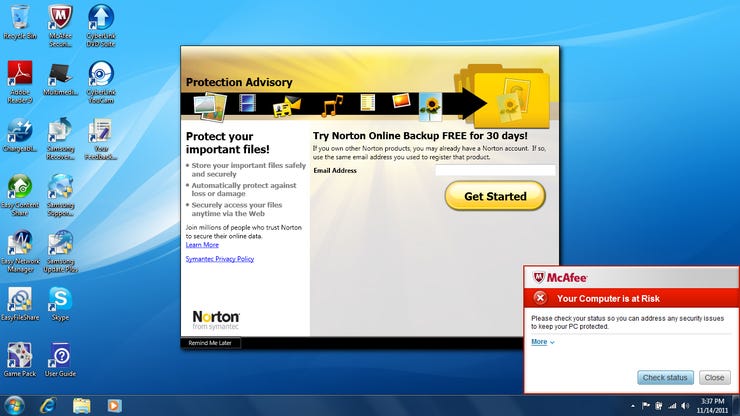Can Microsoft cure PC makers of the crapware habit?

Building a Windows PC is a cooperative process. PC makers design and build the hardware, Microsoft designs and builds the OS, and then third-party software developers join the party. If everything works together, the end result can be a joy to use. But if any part of the partnership breaks down, the poor PC buyer is the one who suffers.
Making PCs is a tough business, with low profit margins and cutthroat competition. To squeeze a few extra bucks out of every PC they sell, some OEMs cut deals to make extra money by preinstalling trial versions of software. If they can convince you to pay for an upgrade to the full version, they make a commission. But those upsell offers (also known as crapware) are annoying, and in the worst case they can slow a PC noticeably.
On top of that, some OEMs feel compelled to "add value" to their hardware by bundling software programs and utilities that duplicate functions already available in Windows. And they can get downright sloppy about the things that really do matter, like updates and drivers.
Over the last decade I have written a lot about this problem. In 2006, I asked Why do new PCs come with so much junkware? In the darkest days of Windows Vista, in early 2008, I found a Sony VAIO PC that represented a truly awful PC experience:
This gorgeous machine was ugly in action: slow to start, sluggish when performing everyday tasks, crash-prone, and overloaded with annoying and unwanted software. But is it really a hopeless case, or was this system done in by the rush to market and a sloppy OEM integration?
In an interview at the time, a Sony senior executive candidly admitted that the problem was all theirs, calling his company's PCs "the poster child for negative experiences people had [with trialware]."
I was able to fix that PC with a clean install and hours of fine-tuning. But that approach doesn't scale and should never have been necessary.
Now, three years later, I'm curious. Have OEMs cleaned up their act? Are today's Windows PCs still a mess or do consumers have a fighting chance?
Fortunately, I found a nearly perfect sample set that also included its own control group. Microsoft sells PCs through the Microsoft Store, both online and in 14 retail outlets in the United States. Those machines are configured with a custom Windows installation that the company calls Microsoft Signature. The rules are stringent:
- No trialware, and no unnecessary startup programs.
- The desktop is clean, with no gadgets, no icons (except for the Recycle Bin), and no unnecessary system try icons.
- Microsoft's free antivirus software is installed and activated, and Windows Update is configured to install updates automatically.
- The Microsoft Signature theme pack, with images drawn from the same pool as those used on Bing, is installed and set as the default background.
- Windows Live Essentials, Office 2010 Starter Edition (not a trialware product), and Zune software are installed and all activations are performed.
- No added mouse/keyboard navigation systems are allowed beyond the Windows Start menu and taskbar.
In addition, the installations are up-to-date, with the latest service packs and updates applied. And the final product includes 90 days of free support from Microsoft.
The goal is to make the experience of using a PC better—not just on unboxing day but for the life of the PC.
So, two months ago, I picked up three pairs of new consumer notebooks, one pair each from HP, Samsung, and Sony. In each case, the hardware was identical but the installed software was different, with one model containing the OEM's standard consumer installation and the other built to Microsoft Signature specs. The differences were eye-opening.
Here, for example, is the out-of-box desktop experience Samsung delivered to customers in 2011. And yes, this PC has trialware offers from both Norton and McAfee.

Here's the same experience, delivered via Microsoft Signature:
I'll have full details about all three pairs of PCs in a follow-up post next week, but here are some high-level conclusions:
- Whatever joy you might feel on unboxing a new PC evaporates quickly if you have to spend hours setting it up. The out-of-box experience with a Signature PC is strikingly better.
- PC OEMs have cut back on trialware, but they haven't broken the habit. The upsell nags for antivirus software are particularly annoying on OEM PCs.
- OEMs continue to insist on superfluous control panels, toolbars, and desktop docks that do nothing for usability.
- Extra software causes usability headaches for even simple tasks, like playing a DVD or downloading pictures.
- The Signature PCs are faster to start up, by an average of 10-15 seconds, but the differences in usability are even more important.
The problem with Microsoft Signature right now is a matter of scale. With only 14 physical stores, the company can reach only a fraction of PC buyers directly, and most people have no idea that the online store sells roughly 60 name-brand notebook and desktop PCs (plus a few tablets) all configured using Microsoft Signature.
Would I recommend a Microsoft Signature PC? For someone who doesn't have the time or the technical skills to do a clean Windows install, absolutely. Removing all that trialware and simplifying the experience makes a PC faster and easier to use.
Back in 2009, when Microsoft opened its retail store in Scottsdale, Arizona, I visited the store with a friend, who purchased a Dell notebook running Windows 7. That machine was one of the first delivered under the Microsoft Signature program, and it has been problem-free ever since. When they replace that PC in a year or two, I have no doubt they'll go back to the same store.